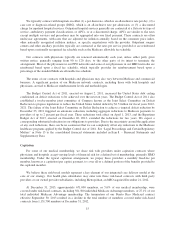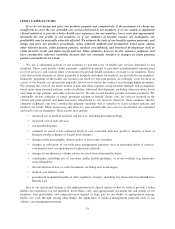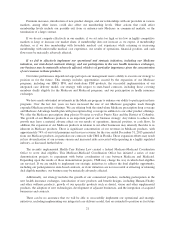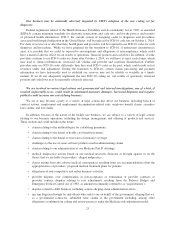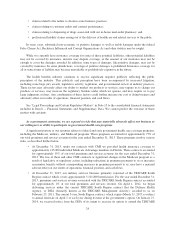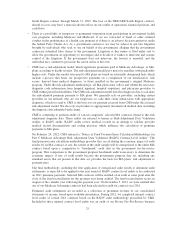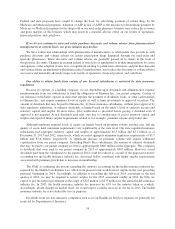Humana 2013 Annual Report Download - page 35
Download and view the complete annual report
Please find page 35 of the 2013 Humana annual report below. You can navigate through the pages in the report by either clicking on the pages listed below, or by using the keyword search tool below to find specific information within the annual report.South Region contract through March 31, 2015. The loss of the TRICARE South Region contract,
should it occur, may have a material adverse effect on our results of operations, financial position, and
cash flows.
• There is a possibility of temporary or permanent suspension from participating in government health
care programs, including Medicare and Medicaid, if we are convicted of fraud or other criminal
conduct in the performance of a health care program or if there is an adverse decision against us under
the federal False Claims Act. As a government contractor, we may be subject to qui tam litigation
brought by individuals who seek to sue on behalf of the government, alleging that the government
contractor submitted false claims to the government. Litigation of this nature is filed under seal to
allow the government an opportunity to investigate and to decide if it wishes to intervene and assume
control of the litigation. If the government does not intervene, the lawsuit is unsealed, and the
individual may continue to prosecute the action on his or her own.
• CMS uses a risk-adjustment model which apportions premiums paid to Medicare Advantage, or MA,
plans according to health severity. The risk-adjustment model pays more for enrollees with predictably
higher costs. Under this model, rates paid to MA plans are based on actuarially determined bids, which
include a process that bases our prospective payments on a comparison of our beneficiaries’ risk
scores, derived from medical diagnoses, to those enrolled in the government’s original Medicare
program. Under the risk-adjustment methodology, all MA plans must collect and submit the necessary
diagnosis code information from hospital inpatient, hospital outpatient, and physician providers to
CMS within prescribed deadlines. The CMS risk-adjustment model uses this diagnosis data to calculate
the risk-adjusted premium payment to MA plans. We generally rely on providers, including certain
providers in our network who are our employees, to code their claim submissions with appropriate
diagnoses, which we send to CMS as the basis for our payment received from CMS under the actuarial
risk-adjustment model. We also rely on providers to appropriately document all medical data, including
the diagnosis data submitted with claims.
CMS is continuing to perform audits of various companies’ selected MA contracts related to this risk
adjustment diagnosis data. These audits are referred to herein as Risk-Adjustment Data Validation
Audits, or RADV audits. RADV audits review medical records in an attempt to validate provider
medical record documentation and coding practices which influence the calculation of premium
payments to MA plans.
On February 24, 2012, CMS released a “Notice of Final Payment Error Calculation Methodology for
Part C Medicare Advantage Risk Adjustment Data Validation (RADV) Contract-Level Audits”. The
final payment error calculation methodology provides that, in calculating the economic impact of audit
results for an MA contract, if any, the results of the audit sample will be extrapolated to the entire MA
contract based upon a comparison to “benchmark” audit data in the government fee-for-service
program. This comparison to the government program benchmark audit is necessary to determine the
economic impact, if any, of audit results because the government program data set, including any
attendant errors that are present in that data set, provides the basis for MA plans’ risk adjustment to
payment rates.
The final methodology, including the first application of extrapolated audit results to determine audit
settlements, is expected to be applied to the next round of RADV contract level audits to be conducted
on 2011 premium payments. Selected MA contracts will be notified of an audit at some point after the
close of the final reconciliation for the payment year being audited. The final reconciliation occurs in
August of the calendar year following the payment year. On November 5, 2013, we were notified that
one of our Medicare Advantage contracts had been selected for audit for contract year 2011.
Estimated audit settlements are recorded as a reduction of premiums revenue in our consolidated
statements of income, based upon available information. During 2012, we completed internal contract
level audits of certain 2011 contracts based on the RADV audit methodology prescribed by CMS.
Included in these internal contract level audits was an audit of our Private Fee-For-Service business
25


